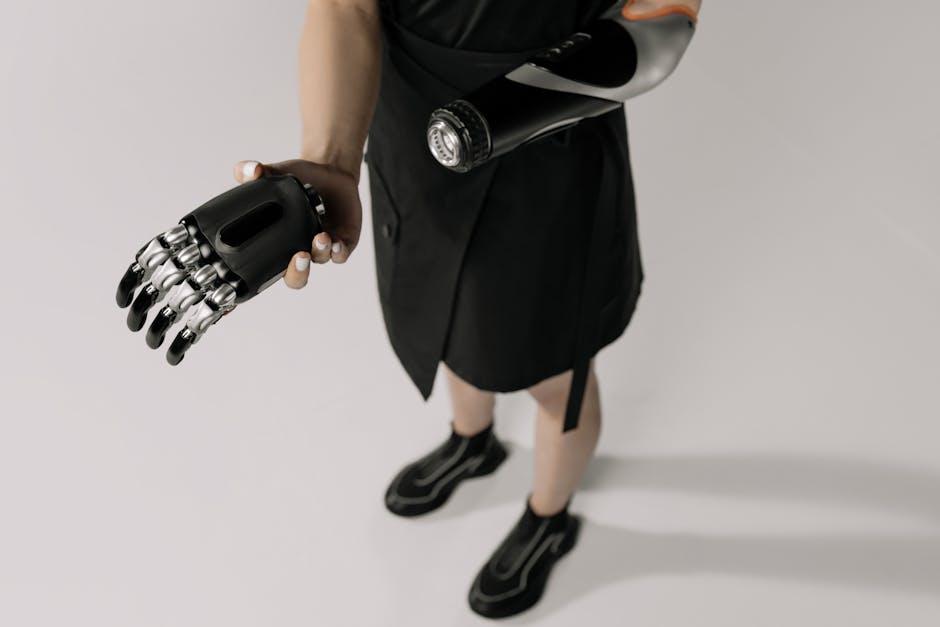Every journey your vehicle takes relies on an intricate dance of components working harmoniously beneath the surface. Among these unsung heroes, control arms play a pivotal role, connecting the wheels to the frame and ensuring smooth, stable rides. But like any well-used part, control arms can wear out, leading to diminished handling and increased risk on the road. Knowing how to replace control arms is not just a handy skill—it’s a step toward greater vehicle safety and confidence behind the wheel. In this guide, we’ll walk you through the process with clear, straightforward steps, empowering you to restore your suspension’s integrity and keep your ride steady.
Table of Contents
- Choosing the Right Control Arms for Your Vehicle
- Essential Tools and Safety Precautions for the Replacement Process
- Step-by-Step Guide to Removing Old Control Arms
- Inspecting and Preparing the Suspension Components for Installation
- Precision Tips for Installing New Control Arms Correctly
- Final Checks and Test Drive Recommendations to Ensure Proper Functionality
- Q&A
- Closing Remarks

Choosing the Right Control Arms for Your Vehicle
When selecting control arms, it’s essential to consider not only the compatibility with your vehicle’s make and model but also the material quality and design. Control arms come in various materials such as stamped steel, forged steel, and aluminum alloy, each with benefits ranging from durability to weight savings. For everyday driving, stamped steel control arms offer reliable strength at an affordable price, whereas forged steel or aluminum arms are often preferred for performance or off-road vehicles due to their enhanced resilience and lighter weight.
Additionally, think about the features and finish of the control arms, such as:
- Bushing type: Rubber or polyurethane bushings affect ride comfort and handling precision.
- Ball joint integration: Some control arms come with pre-installed ball joints for ease of installation.
- Corrosion resistance: Powder-coated or zinc-plated finishes help prolong lifespan, especially in harsh climates.
| Material | Best For | Durability | Cost |
|---|---|---|---|
| Stamped Steel | Daily Driving | Good | Low |
| Forged Steel | Performance & Off-Road | Excellent | Medium to High |
| Aluminum Alloy | Weight Savings & Durability | Very Good | High |

Essential Tools and Safety Precautions for the Replacement Process
Before diving into the mechanical work of replacing control arms, having the right tools at your disposal not only ensures efficiency but also safeguards the integrity of your vehicle’s suspension system. Essential implements include a quality socket set with ratchets and extensions for tight spaces, a reliable torque wrench to precisely tighten bolts to manufacturer specifications, and a ball joint separator for quick and safe removal of the ball joints. Don’t forget a sturdy jack and jack stands to safely elevate and support your vehicle, as working underneath requires unwavering stability. Additionally, penetrating oil can be a lifesaver when tackling rusty bolts, and a rubber mallet helps in loosening stubborn components without causing damage.
Safety should always be your top priority when working under the vehicle’s chassis. Always wear protective gear like safety goggles and gloves to prevent injuries from flying debris or accidental slips. Ensure your workspace is well-lit and free from clutter, ideally on a flat surface to keep the jack stands steady. Never rely solely on a hydraulic jack to hold your vehicle; always use jack stands as a backup. If possible, enlist a friend for assistance during critical steps, especially when handling heavy parts or navigating complex reinstallation procedures. Following these precautions minimizes risks and helps the replacement process go smoothly.

Step-by-Step Guide to Removing Old Control Arms
Begin by securely elevating the vehicle using a jack and supporting it with jack stands to ensure safety. Locate the old control arms, typically attached to the vehicle’s frame and the wheel assembly. Before loosening any bolts, spray penetrating oil on the joints to ease removal. Using the appropriate wrenches and sockets, carefully remove the bolts and nuts connecting the control arm to both the chassis and the steering knuckle. You might encounter stubborn bolts due to rust or tight torque, so patience and steady force are key.
Once detached, gently maneuver the control arm out of its mounting points. Keep an eye on the ball joint and bushings — these components often require attention or replacement along with the control arm. During this process, collect and organize all hardware using a labeled container or tray, which will prove invaluable during reinstallation. To help clarify the disassembly process, here’s a quick reference guide outlining typical bolt positions and their recommended torque values:
| Mounting Point | Bolt Size | Torque (ft-lbs) |
|---|---|---|
| Chassis Bracket | 14mm | 80 |
| Ball Joint | 17mm | 90 |
| Steering Knuckle | 15mm | 85 |

Inspecting and Preparing the Suspension Components for Installation
Before diving into the installation process, it’s crucial to thoroughly examine all the suspension parts you’ll be working with. Start by cleaning each component with a wire brush or appropriate cleaner to remove dirt, rust, and old grease. This allows you to spot any cracks, bends, or wear that could compromise the integrity of the control arm or related parts. Next, inspect the bushings and ball joints for any signs of excessive play or deterioration. These small connections play a huge role in ensuring a smooth ride and safe handling. Don’t forget to double-check mounting bolts and washers for any damage—they should be replaced if they show signs of wear.
Preparing the components correctly can save you time and headaches during reassembly. Before installation, apply high-quality grease to the ball joints and bushings to promote longevity and reduce noise. Arrange the parts on a clean workspace, keeping the new control arm, nuts, bolts, and any shims or spacers neatly organized. This system will streamline the process and help avoid missing parts. Below is a simple checklist to guide your preparation phase:
- Clean all suspension components thoroughly
- Inspect for cracks, bends, or wear in metal parts
- Examine bushings and ball joints for damage
- Replace any worn bolts, nuts, or washers
- Apply grease to moving parts before installation
- Organize components for easy access during assembly
| Component | Inspection Tip | Preparation Step |
|---|---|---|
| Control Arm | Check for bends or cracks | Clean and degrease surface |
| Ball Joints | Assess for looseness or torn boot | Apply fresh grease |
| Bushings | Look for excessive wear or cracks | Replace if necessary, lubricate lightly |
| Bolts & Nuts | Ensure threads are clean and undamaged | Use new hardware when possible |

Precision Tips for Installing New Control Arms Correctly
Ensuring perfect alignment during control arm installation is paramount. Begin by carefully comparing the new parts with the originals to verify exact matches in size, shape, and mounting points. Using a torque wrench calibrated to your vehicle’s specifications not only secures bolts firmly but prevents damage caused by over-tightening. Remember, snug does not mean tight: gradual tightening in a crisscross pattern helps distribute pressure evenly, reducing stress on bushings and joints.
Prior to finalizing installation, pay attention to the following key checkpoints to avoid future issues or premature wear:
- Clean contact surfaces thoroughly to remove dirt and rust for a perfect sit.
- Lubricate any metal-on-metal contact points sparingly with approved grease.
- Double-check bolt threads for any signs of corrosion or damage before reusing.
- Ensure that all hardware supplied with the replacement parts is utilized as recommended.
| Step | Precision Focus |
|---|---|
| 1 | Verify part compatibility before removal |
| 2 | Apply correct torque values gradually |
| 3 | Inspect and clean all mounting points |
| 4 | Lubricate contact areas as needed |

Final Checks and Test Drive Recommendations to Ensure Proper Functionality
Once your new control arms are securely installed, it’s crucial to conduct a thorough inspection before hitting the road. Start by rechecking all bolts and nuts for tightness using a torque wrench to match manufacturer specifications. Pay special attention to the bushings and ball joints; ensure they are properly seated and show no signs of stress or misalignment. A quick manual test by gently moving the suspension components can help detect any unusual play or binding that could compromise safety. Additionally, inspect adjacent parts like sway bar links and tie rods to confirm they remain undisturbed during the replacement process.
Before returning to normal driving routines, take your vehicle on a carefully monitored test drive to observe the new control arms’ performance. During this drive, be alert to any odd noises such as clunks or squeaks, and note if the steering feels loose or if the car pulls to one side. Incorporate the following practices for an effective test drive:
- Begin with slow speeds in a safe, open area
- Gradually increase speed while testing various steering inputs
- Navigate a few gentle turns and then sharper cornering
- Listen closely for unusual sounds from the suspension
Completing these steps ensures your control arm replacement meets safety and performance standards, giving you confidence in the road ahead.
Q&A
Q: What exactly are control arms, and why are they important?
A: Control arms are crucial suspension components that connect your vehicle’s frame to the wheels. They allow for smooth up-and-down movement, helping maintain stability and steering precision. Think of them as the unsung heroes keeping your ride comfortable and safe.
Q: How do I know if my control arms need replacing?
A: Common signs include clunking noises when driving over bumps, uneven tire wear, a wandering steering wheel, or a shaky feel at higher speeds. If you notice any of these, it might be time for a closer look.
Q: What tools will I need to replace control arms?
A: You’ll want a basic socket set, wrenches, a ball joint separator, a jack and jack stands, and possibly a breaker bar for stubborn bolts. Having a repair manual or guide specific to your vehicle model can also be a big help.
Q: Is replacing control arms something I can do myself?
A: If you’re comfortable working with car suspension components and have the right tools and space, yes. However, control arms affect steering and safety, so if you’re unsure, it’s best to consult a professional.
Q: What’s the general process for replacing control arms?
A: First, safely lift and secure your vehicle. Remove the wheel, then detach the old control arm by unbolting it from the frame and the steering knuckle. Transfer any components like bushings if reusable or install new ones. Finally, install the new control arm, torque bolts to specs, and reassemble everything.
Q: Do I need an alignment after replacing control arms?
A: Absolutely. Replacing control arms can alter suspension geometry, so a professional wheel alignment is essential to ensure proper handling and to prevent uneven tire wear.
Q: How long does it typically take to replace control arms?
A: On average, an experienced DIYer might spend 2 to 4 hours per side, depending on the vehicle and any complications like rusted bolts or seized components.
Q: Are there any safety precautions I should keep in mind?
A: Always work on a flat surface and use quality jack stands—never rely on a jack alone. Wear gloves and eye protection, and carefully follow torque specifications to avoid loose or over-tightened fittings.
Q: Can upgrading to aftermarket control arms improve my vehicle’s performance?
A: Upgrading can offer benefits like improved durability or adjustability, especially for off-road or performance applications. However, it’s important to choose parts compatible with your vehicle and driving needs.
Q: Where can I find replacement control arms?
A: Trusted auto parts stores, online retailers, or directly from your vehicle manufacturer’s dealership are good sources. Be sure to pick control arms specifically designed for your make and model.
Closing Remarks
Replacing control arms might seem like a daunting task, but with patience, the right tools, and a bit of mechanical know-how, it’s a manageable project that can breathe new life into your vehicle’s handling and safety. Each bolt tightened and bushing replaced brings you one step closer to smoother rides and greater peace of mind on the road. So roll up your sleeves, trust the process, and remember: taking control of your car’s maintenance isn’t just about fixing parts—it’s about driving with confidence.

